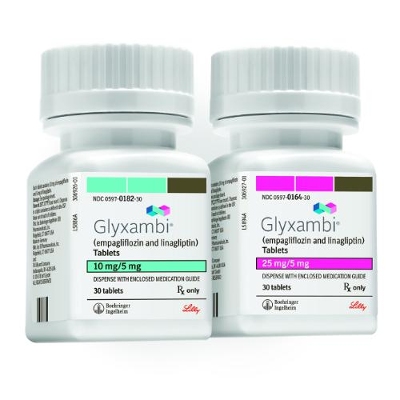One Pill, One Co-pay: Combo Drug Glyxambi Now Available at Pharmacies Nationwide in the US
 Update (4/3/15): On March 23, Lilly/BI announced the US launch of Glyxambi at pharmacies nationwide. This launch comes two months after FDA approval and represents the first SGLT-2 inhibitor/DPP-4 inhibitor fixed dose combination drug available in the US. Its main benefit is combining two different diabetes drugs into a single pill (in this case, Tradjenta and Jardiance) with one co-pay. Glyxambi has a savings card program available that allows many with insurance to pay nothing for a year, with renewals available until March 2018. That said, Glyxambi is expensive for those without insurance – at our local Walgreens, the out-of-pocket cash price is $581 for 30 pills. This is more expensive than Jardiance ($411) or Tradjenta ($414) alone, though significantly lower than the combination ($825).
Update (4/3/15): On March 23, Lilly/BI announced the US launch of Glyxambi at pharmacies nationwide. This launch comes two months after FDA approval and represents the first SGLT-2 inhibitor/DPP-4 inhibitor fixed dose combination drug available in the US. Its main benefit is combining two different diabetes drugs into a single pill (in this case, Tradjenta and Jardiance) with one co-pay. Glyxambi has a savings card program available that allows many with insurance to pay nothing for a year, with renewals available until March 2018. That said, Glyxambi is expensive for those without insurance – at our local Walgreens, the out-of-pocket cash price is $581 for 30 pills. This is more expensive than Jardiance ($411) or Tradjenta ($414) alone, though significantly lower than the combination ($825).
Original Article (2/17/15):
Twitter summary: FDA approves Glyxambi, combines Jardiance + Tradjenta into a single pill w/ A1c, weight loss, and blood pressure benefits
Lilly/BI announced that the FDA has approved their fixed-dose combination drug Glyxambi for type 2 diabetes. Glyxambi combines two different drug classes into a single pill: Jardiance (its "technical name" is empagliflozin, an SGLT-2 inhibitor) plus Tradjenta (the "technical name" is linagliptin, a DPP-4 inhibitor). Glyxambi is the first-ever SGLT-2/DPP-4 inhibitor combination drug to be approved in the US. It will be available in two doses (10 mg empagliflozin/5 mg linagliptin and 25 mg empagliflozin/5 mg linagliptin) to be taken once-daily in the morning. It is recommended for people with type 2 diabetes who are not reaching their A1c goals with current drugs. There is no information yet on pricing or insurance coverage for Glyxambi (at least not any we could find!). In short, the advantages of Glyxambi are convenience (single pill), potentially lower cost (one co-pay), and a relatively mild side-effect profile for most patients. For more background on SGLT-2/DPP-4 inhibitor fixed dose combinations, please see our recent learning curve on the topic.
In a one-year clinical trial of participants already using metformin, Glyxambi (at both doses) led to larger A1c reductions compared to either Jardiance or Tradjenta alone. From a starting A1c of 8.0%, Glyxambi led to an A1c drop of 1.2% at the high dose and 1.1% at the low dose, compared to a 0.7% drop with Jardiance and 0.5% with Tradjenta. Participants on either dose of Glyxambi also saw significant improvements in body weight (about 3 lbs of weight loss) and small declines in blood pressure (about 3 mm Hg), which is comparable to the weight loss and blood pressure benefits seen with Jardiance alone. So is Glyxambi better than just taking one drug? It will certainly depend on individual preferences, but Glyxambi's A1c benefits could strengthen its appeal.
Lilly/BI plan to submit Glyxambi for approval in Europe in 2015. AstraZeneca has also recently submitted its combination of Farxiga (dapagliflozin) and Onglyza (saxagliptin) for approval in the US and plans to do so in Europe near the middle of the year. This combination has had similar A1c improvements as Glyxambi in clinical trials, and it could become available (pending approval) by late 2015 or early 2016. Looking ahead, combination drugs that include three (!) different drug classes may be the next frontier for type 2 diabetes drugs. For example, AstraZeneca is conducting two clinical trials of triple therapy with Onglyza, Farxiga, and metformin (taken as separate tablets in the studies, but these might be combined into a single pill). This triple combination is an exciting prospect, and we’re interested to learn more down the line on how easy it will be to actually mix three drugs into a single pill. –MV/AJW/ER







